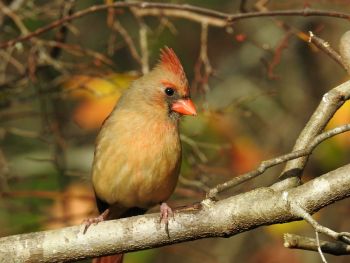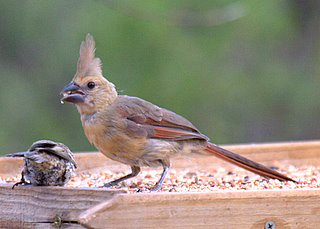Sbarnhardt (talk | contribs) (Add Clearer Image - Female - Danielbirdwatcher to Identification section) |
Sbarnhardt (talk | contribs) (Deerbird image moved to Behavior, ldsmith image moved to Taxonomy,) |
||
| Line 18: | Line 18: | ||
==Taxonomy== | ==Taxonomy== | ||
| + | [[Image:Northern_Cardinal_Juvenile_Male.jpg|thumb|350px|right|Juvenile Male<br />Photo © by {{user|ldsmith|Larry D Smith}}<br />[[Arizona]], [[USA]], 21 July 2007]] | ||
Formerly placed in the genus ''Richmondena'' | Formerly placed in the genus ''Richmondena'' | ||
| − | + | ||
====Subspecies==== | ====Subspecies==== | ||
There are 18 subspecies<sup>[[#References|[1]]]</sup>: | There are 18 subspecies<sup>[[#References|[1]]]</sup>: | ||
| Line 44: | Line 45: | ||
Suburban Woodlands and parks, mixed forests and forest edges, back yards, high desert. | Suburban Woodlands and parks, mixed forests and forest edges, back yards, high desert. | ||
==Behaviour== | ==Behaviour== | ||
| − | + | [[Image:Febflyby.jpg|thumb|350px|right|Male<br />Photo © by {{user|Deerbird|Deerbird}}<br />[[Kentucky]], [[USA]], 18 February 2018]] | |
Winter flocks can be very large, up to 60 or 70 individuals in areas of abundance. | Winter flocks can be very large, up to 60 or 70 individuals in areas of abundance. | ||
====Diet==== | ====Diet==== | ||
Their diet consists mostly of fruit and berries, buds, seeds and flowers, insects being included during the summer. | Their diet consists mostly of fruit and berries, buds, seeds and flowers, insects being included during the summer. | ||
====Breeding==== | ====Breeding==== | ||
| − | + | ||
<!--EDITORS: these two juvenile images do not appear in the Gallery--> | <!--EDITORS: these two juvenile images do not appear in the Gallery--> | ||
Male courts female by singing, chasing, and fluttering of wings. Once paired the male feeds the female. May mate for life.<br/> | Male courts female by singing, chasing, and fluttering of wings. Once paired the male feeds the female. May mate for life.<br/> | ||
| Line 60: | Line 61: | ||
It appears there may be varying accents in different localities. | It appears there may be varying accents in different localities. | ||
====Movements==== | ====Movements==== | ||
| + | |||
Generally sedentary with irregular, occasional long-distance movements. | Generally sedentary with irregular, occasional long-distance movements. | ||
Revision as of 14:59, 15 February 2021
- Cardinalis cardinalis
Identification
Male 22–23·5 cm (8½-9¼in), female 21–21·6 cm (8¼-8½ in)
All ages and sexes have a crest and large, conical bill
Male
- All red with black mask and chin
- Wings have some gray
- Orange bill
Female
- Brown overall with some red in wings, face, and tail
- Red bill
Juvenile
Similar to female but bill is dark instead of red.
Distribution
United States and Mexico. Introduced populations are found in Hawaii and Bermuda.
Taxonomy
Formerly placed in the genus Richmondena
Subspecies
There are 18 subspecies[1]:
- C. c. superbus: Extremee California to Arizona, south-western New Mexico and northern Sonora
- C. c. seftoni: Central Baja California (south to latitude 27°N)
- C. c. igneus: Southern Baja California (north to latitude 27°N)
- C. c. clintoni: Isla Cerralvo (Gulf of California)
- C. c. townsendi: Isla Tiburón (Sea of Cortés) and adjacent coastal Sonora
- C. c. affinis: Western Mexico (south-eastern Sonora to south-western Chihuahua and western Durango)
- C. c. sinaloensis: Coastal western Mexico (Sinaloa and Jalisco)
- C. c. mariae: Tres Marías Islands (off western Mexico)
- C. c. cardinalis: Eastern US
- C. c. floridanus: South-eastern Georgia and peninsula Florida
- C. c. magnirostris: South-eastern Texas and southern Louisiana
- C. c. canicaudus: Western Oklahoma and western Texas to east-central Mexico
- C. c. coccineus: Eastern Mexico (eastern San Luis Potosí, Veracruz, north-eastern Puebla and n Oaxaca)
- C. c. littoralis: Lowlands of eastern Mexico (southern Veracruz and Tabasco)
- C. c. yucatanicus: South-eastern Mexico (Yucatán Peninsula)
- C. c. flammiger: South-eastern Mexico (southern Quintana Roo), Belize and Petén of northern Guatemala
- C. c. saturatus: Cozumel Island (off Quintana Roo)
- C. c. carneus: (Long Crested) Coastal western Mexico (Colima to Isthmus of Tehuántepec)
Habitat
Suburban Woodlands and parks, mixed forests and forest edges, back yards, high desert.
Behaviour
Winter flocks can be very large, up to 60 or 70 individuals in areas of abundance.
Diet
Their diet consists mostly of fruit and berries, buds, seeds and flowers, insects being included during the summer.
Breeding
Male courts female by singing, chasing, and fluttering of wings. Once paired the male feeds the female. May mate for life.
The shallow cup-shaped nest is constructed mainly by the female from twigs, bark, grass and leaves. The clutch consists of 3-4 eggs which are incubated for 12-13 days. The young fledge at about 10 days. The youngsters are generally looked after by the male.
There may be a second brood.
Vocalisation
Song: a clear whistling song. Females will sing along with the male.
It appears there may be varying accents in different localities.
Movements
Generally sedentary with irregular, occasional long-distance movements.
References
- Clements, J. F., T. S. Schulenberg, M. J. Iliff, S. M. Billerman, T. A. Fredericks, B. L. Sullivan, and C. L. Wood. 2019. The eBird/Clements Checklist of Birds of the World: v2019. Downloaded from http://www.birds.cornell.edu/clementschecklist/download/
- All About Birds, Cornell Lab of Ornithology
- BirdForum Member observations
- Virtual Nature Trail at Penn State
- Brewer, D. (2020). Northern Cardinal (Cardinalis cardinalis). In: del Hoyo, J., Elliott, A., Sargatal, J., Christie, D.A. & de Juana, E. (eds.). Handbook of the Birds of the World Alive. Lynx Edicions, Barcelona. (retrieved from https://www.hbw.com/node/62186 on 11 February 2020).
- Halkin, S. L. and S. U. Linville (1999). Northern Cardinal (Cardinalis cardinalis), version 1.0. In The Birds of North America (A. F. Poole and F. B. Gill, Editors). Cornell Lab of Ornithology, Ithaca, NY, USA. https://doi.org/10.2173/bna.440
- Pratt, H.D., Bruner, P., and Berrett, D.G. (1987) A Field Guide to the Birds of Hawaii and the Tropical Pacific. Princeton University Press.
- Pyle, R.L., and P. Pyle. 2017. The Birds of the Hawaiian Islands: Occurrence, History, Distribution, and Status. B.P. Bishop Museum, Honolulu, HI, U.S.A. Version 2 (1 January 2017) http://hbs.bishopmuseum.org/birds/rlp-monograph/
Recommended Citation
- BirdForum Opus contributors. (2024) Northern Cardinal. In: BirdForum, the forum for wild birds and birding. Retrieved 6 May 2024 from https://www.birdforum.net/opus/Northern_Cardinal
External Links








